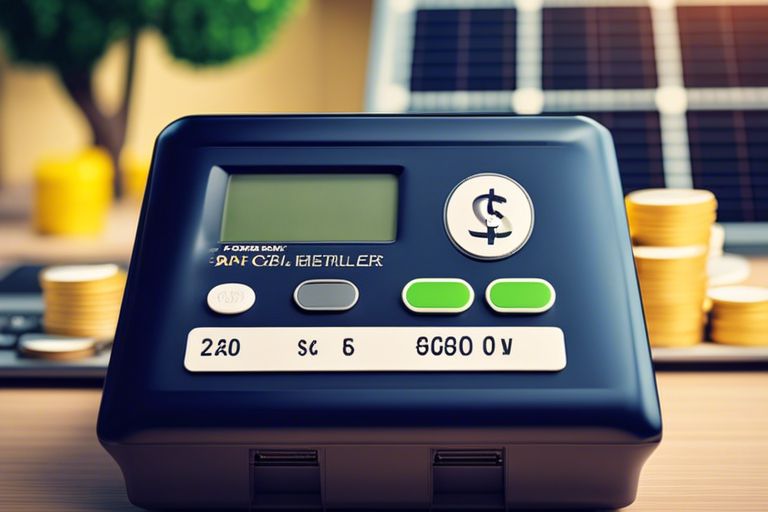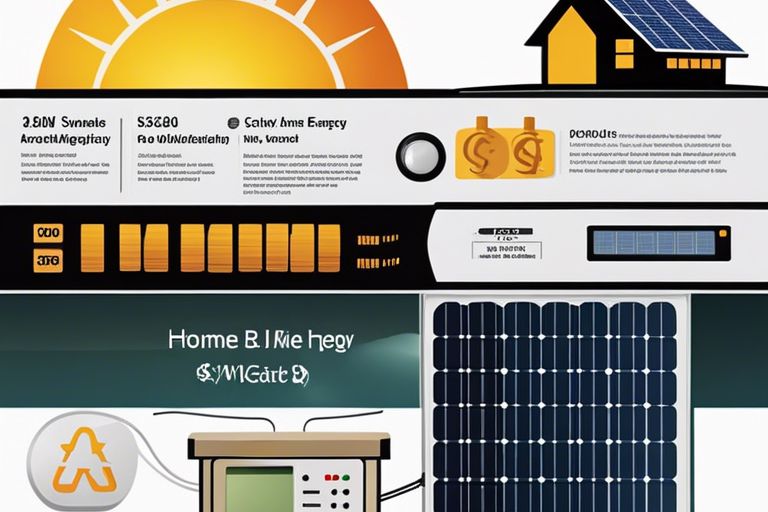Understanding Your Electric Bill Before and After Going Solar can seem like a complex process, but when you have solar, it’s actually quite straightforward. Your solar panels generate electricity during the day, reducing the amount of electricity you need to buy from the grid. This means that your electric bill can significantly decrease. However, you are still connected to the grid and may need to pay for any excess electricity you use at night or on cloudy days. Understanding how billing works when you have solar can help you make the most out of your investment.
Key Takeaways:
- Net metering: With net metering, any excess energy your solar panels produce is sent back to the grid and you receive credits for it on your electricity bill.
- True-up period: At the end of a specified period (typically annually), your energy usage and production are reconciled, and you may owe money or receive a credit based on the net amount of energy consumed.
- Solar incentives: Some utility companies may offer additional incentives for solar panel owners, such as rebates or performance-based incentives, which can further impact your billing structure.
How Solar Billing Works
To understand how billing works when you have solar panels, it’s imperative to familiarize yourself with concepts like net metering and grid ties. These elements play a crucial role in determining how your energy production is measured and how you interact with the utility grid.
Net Metering: Measuring Your Energy Production
Net metering is a billing arrangement that allows you to receive credit for the excess electricity your solar panels generate and send back to the grid. Essentially, when your panels produce more energy than your home consumes, the surplus is fed back into the grid, spinning your meter backward and giving you credit that can offset future electricity bills.
Grid Ties: Connecting to the Utility Grid
An imperative component of solar billing is the grid tie, which connects your solar panel system to the utility grid. This connection enables you to access electricity from the grid when your panels aren’t generating enough power, ensuring a reliable source of energy for your home.
For instance, on cloudy days or during nighttime when solar panels are not producing electricity, you can draw power from the grid to meet your household’s energy needs. This seamless transition between solar-generated electricity and grid-supplied power helps to ensure uninterrupted energy access while optimizing cost savings.
Billing Cycles and Meter Readings
Monthly Billing Cycles: What to Expect
One important aspect to understand about billing when you have solar panels is the monthly billing cycle. Your utility company will still send you a monthly bill, but it will look slightly different now that you are producing some of your own energy. Instead of just paying for the total energy consumed from the grid, your bill will reflect the net amount of energy you used after subtracting the energy your solar panels generated.
Meter Readings: How Your Energy Production is Tracked
Readings from your meter play a crucial role in tracking your energy production with solar panels. Your utility company will typically install a bidirectional meter that can measure both the electricity you consume from the grid and the excess electricity your solar panels feed back into the grid. This allows for accurate billing based on your net energy usage.
Tracked consistently, these readings provide insight into how much energy your solar system is producing and how much energy you are actually using from the grid. This data is crucial for calculating your savings and ensuring that your system is functioning optimally.
Solar Energy Credits
What are Solar Energy Credits?
With solar energy credits, you can earn credits for the excess energy your solar panels produce that is sent back to the grid. These credits can then be used to offset your future electricity bills, providing you with savings over time.
How Solar Energy Credits are Calculated
Any excess energy your solar panels generate is measured by your utility company through a net metering system. The credits you receive are typically calculated based on the amount of kilowatt-hours of electricity you send back to the grid. This allows you to earn credits during the day when your solar panels are producing more energy than you are using, which you can then use at night or on cloudy days.
Solar energy credits are a great way to maximize the benefits of your solar panels and reduce your overall electricity costs. By understanding how these credits are calculated, you can make the most out of your solar energy system and see significant savings on your energy bills.
Using Solar Energy Credits to Offset Your Bill
Credits from solar energy can be a valuable tool for reducing your electricity costs. By using these credits to offset your future bills, you can see even greater savings on your energy expenses. This can help make your investment in solar panels even more worthwhile over time.
Solar energy credits provide you with a way to not only reduce your carbon footprint but also save money on your electricity bills. By utilizing these credits effectively, you can enjoy the full benefits of solar energy and make a positive impact on both the environment and your wallet.

Time-of-Use (TOU) Rates
Once again, you may come across Time-of-Use (TOU) rates when exploring billing options for your solar system. TOU rates vary depending on the time of day, day of the week, and season. With TOU rates, the amount you pay for electricity can change based on when you use it. Generally, electricity is more expensive during peak hours when demand is high, and cheaper during off-peak hours when demand is lower.
What are TOU Rates?
With TOU rates, you are charged different rates for electricity based on the time of day. Peak hours typically fall during times of high energy usage, such as evenings when people return home from work and schools are running. Off-peak hours, on the other hand, are times when energy demand is lower, like late at night or early in the morning. Some utility companies offer more than two rate tiers, with intermediate rates during shoulder periods of demand.
How TOU Rates Affect Your Solar Billing
Rates for electricity under TOU pricing can have a significant impact on your solar billing. It is crucial to understand your usage patterns and adjust them to take advantage of lower rates during off-peak hours. Solar panels generate the most electricity during daylight hours when TOU rates may be higher. By shifting your energy usage to off-peak hours and storing excess solar energy in batteries, you can reduce your overall electricity costs.

Peak and Off-Peak Hours
Peak Hours: When Energy Demand is High
For solar panel owners, understanding peak hours is crucial to optimizing your energy savings. Peak hours typically occur during the day when energy demand is at its highest. During this time, electricity costs are also higher as the grid struggles to keep up with the increased demand.
Off-Peak Hours: When Energy Demand is Low
Energy costs during off-peak hours are lower as demand decreases, usually at night or early morning when businesses are closed, and many households are asleep. This is the ideal time to use energy-intensive appliances or charge electric vehicles if you have time-of-use billing. Taking advantage of off-peak hours can help maximize your solar energy savings.
During off-peak hours, your solar panels may still be generating energy, especially if you have battery storage to store excess energy produced during the day. This stored energy can be used during off-peak hours, further reducing your reliance on the grid and lowering your overall energy costs.
Seasonal Variations in Energy Production
How Seasonal Changes Affect Your Energy Production
Seasonal changes have a significant impact on your solar energy production. During the summer months when the days are longer and the sun is higher in the sky, your solar panels generate more energy. Conversely, in the winter when days are shorter and there are more clouds, your energy production may decrease. It’s important to be mindful of these fluctuations to understand how they may affect your energy bill. For more detailed information on this topic, you can refer to the Solar Billing Plan FAQ.
How to Optimize Your Solar Panel System for Seasonal Changes
Changes in season require adjustments to optimize your solar panel system’s efficiency. To mitigate the impact of seasonal variations on your energy production, you can consider a few key strategies. Firstly, investing in a solar battery storage system can help store excess energy generated during peak seasons for use during low-producing periods. Secondly, ensuring that your panels are kept clean and free of debris can maximize their exposure to sunlight. By adopting these optimizations, you can make the most of your solar panel system year-round.
Additionally, consulting with a solar energy professional can provide you with tailored advice on optimizing your system for seasonal changes. They can offer insights on how to adjust your energy usage patterns to align with the seasonal fluctuations in solar energy production. This proactive approach can help you maximize the benefits of your solar panel system and reduce your reliance on the grid during times of lower energy production.
Final Words
Following this explanation of how billing works with solar energy, you now have a better understanding of the process. By being connected to the grid, you are able to both give and take electricity as needed, with excess energy providing credits on your bill. This system allows you to not only save money but also contribute to a more sustainable energy future. Understanding your billing process can help you make the most of your solar energy system.
Q: How is solar energy billed?
A: Solar energy billing is typically done through a process called net metering. With net metering, any excess electricity your solar panels generate is sent back to the grid in exchange for credits on your utility bill. These credits can then be used when your solar panels are not generating enough electricity, such as at night or on cloudy days.
Q: What happens if I generate more electricity than I use?
A: If you generate more electricity than you use in a billing period, the excess energy is typically credited to your account for future use. These credits are often called net metering credits and can offset any electricity you use from the grid when your solar panels are not generating enough power.
Q: How often will I receive a bill with solar panels?
A: The frequency of your bills with solar panels will depend on your utility company and billing cycle. You may still receive a monthly bill, but the amount you owe could be reduced or even eliminated if your solar panels cover all or most of your electricity usage.
Q: Will I still need to pay for electricity if I have solar panels?
A: While having solar panels can significantly reduce your electricity bills, you may still need to pay a monthly fee to remain connected to the grid. This fee, often called a grid connection or service fee, covers the costs of maintaining the grid infrastructure and providing backup power when your solar panels are not producing enough electricity.
Q: How can I track my solar energy production and billing credits?
A: Most solar energy systems come with monitoring tools that allow you to track how much electricity your solar panels are generating and how many credits you are accumulating. Additionally, your utility company should provide you with detailed information on your billing credits and usage either on your bill or through an online portal.
